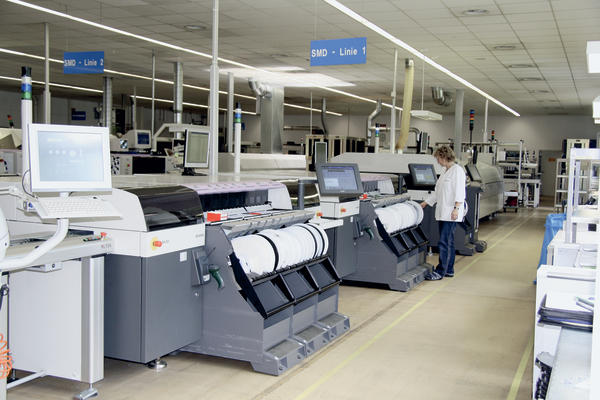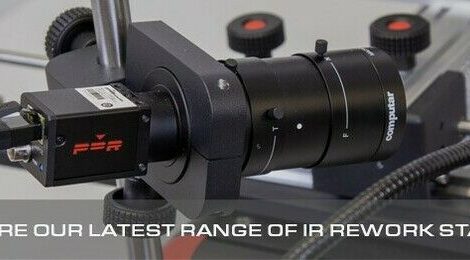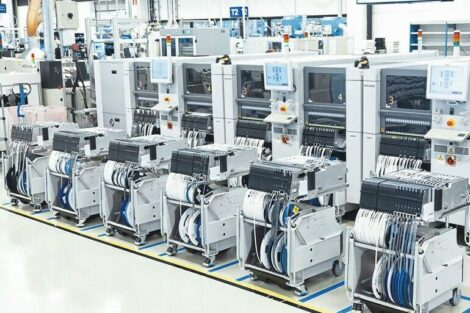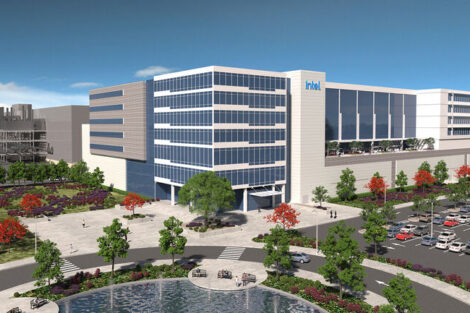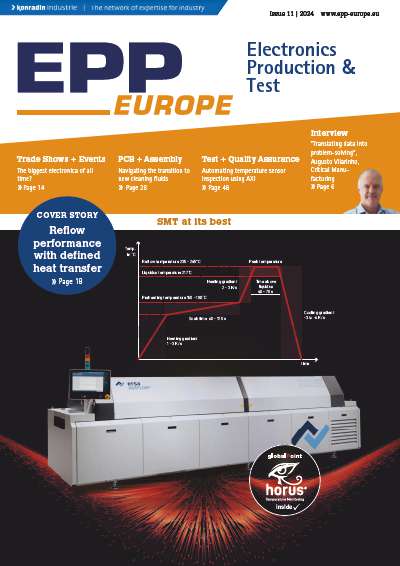With a reputation that has fundamentally been built on quality, German electronics manufacturer TechniSat has become a leading global supplier of TV related products. It has a wide range of decoders and related equipment for satellite, cable and TV/DVD/DVB. Over ten years ago, it also started producing automotive electronics products including radio and navigation electronics for some of the largest European carmakers. A string of successful products has meant placing a huge number of components, which needed new production investment.
TechniSat’s latest navigation radio for example combines four different devices within one system: a digital 1-DIN car radio, CD player, MP3 player and modern navigation system. That means the vehicle only needs a single device. Since TechniSat wanted to place all the system’s components using SMD, the Pick & Place line had to accept a wide range of very different components.
These range from 0402 types right up to 50 x 50 mm BGAs, along with special and odd-form components like snap-in connectors. Automotive products also need high product volumes, with TechniSat needing to place around 35 million SMD components per month. With several different navigation systems and radio product lines, this could not be at the expense of versatile product changes. Furthermore, the components placed needed to be traceable to meet another key automotive requirement. Perhaps the most important need, though, was for precise and reliable placement to meet the exceptionally high quality demands of automotive manufacture. “We needed high throughput machines, but above all we needed high quality placement,” said Detlef Rupp of TechniSat in Dippach, Germany.
Good relationship
TechniSat already had a good relationship with Assembléon from 1992 when the company used two Assembléon MCM 8 machines to make satellite receivers. The machines have run faultlessly since they were installed, and they were more recently joined in the TechniSat production lines by Assembléon’s GEM machines. Since then, TechniSat has continually expanded its product range. Apart from satellite antennas, it has added a range of international digital receivers. Today, TechniSat produces digital receivers for the reception of digital satellite, cable and terrestrial (DVBS/-C/-T) television, along with multi-switches, head stations, accessories for installation, and PC components. The company has throughout adhered firmly to its philosophy of developing and producing high quality and consumer friendly products in Germany.
That gives its products the prestigious “Made in Germany” label, and helps to maintain jobs in the country. Today, the company’s products are developed at TechniSat Digital GmbH in Dresden and produced in three German locations: TechniSat Thüringen GmbH (Dippach near Eisenach), TechniSat Vogtland GmbH (Schöneck in the Vogtland) and TechniSat Teledigital AG (Staßfurt near Magdeburg). TechniSat’s manufacturing plants work very closely with their customers and the company’s development department to ensure early on that new products are easily manufactured. Circuits need to work well first time, and so are designed for easy manufacture on Pick & Place machines.
Single-digit defects per million figures
In 2007, TechniSat set up a line based on Assembléon’s A-Series, with two Assembléon AX-301 machines and one AX-201. The A-Series has been designed to reduce placement variation for highest First Pass Yield. With up to 12 heads on the AX-310, a relatively low 8,250 components per hour head speed gives outputs of 99,000 components per hour. Even at full speed, the machines have 3-sigma accuracy within 40 microns. The AX-201 is an end-of-line/stand-alone machine that places bare die products, high-pin-count ICs and odd-form components with 20-micron placement accuracy.
Precision is essential for the latest generations of electronic equipment. A-Series machines can even place 01005 components in between QFP (Quad Flat Pack) leads that only allow for 15 microns free space, again at full speed. Such small components crack easily, and must be placed very delicately. Components like large snap-fit connectors need more force, which therefore has to be determined per individual component (from 1.5 to 8 N for the AX-301, and 0.9 to 40 N for the AX-201). The A-Series uses parallel placement, which gives defects per million figures that are routinely below 10 – an industry benchmark. First-pass yields have even exceeded 99.8% to save scrap and rework to streamline the whole product manufacturing process.
Modular design
The A-Series (which also includes the AX-501, which places up to 165,000 components per hour) is modular, and shares a common user interface, software, feeder range, trolleys, trays and placement heads.
This modular design is essential for high-mix manufacturing. Fast changeover times makes demands on board transport, nozzle and feeder exchange, and set-up programming.
TechniSat is finding that offline trolley preparation and auto calibration is reducing product changeovers to less than ten minutes. The modular approach allows a better balance between front and back end processes, and minimizes machine over- or under-capacity. Capacity can be redistributed between lines without even rearranging the footprint for easy handling of changing application mixes and capacities. Because machine-specific details are kept out of the production recipe, a production run on an AX-301 can even be transferred ‘on the fly’ to another A-Series machine without losing accuracy or quality.
Reliable assembly is particularly important during prototype manufacture, since prototypes may only have a single set of components. A single faulty component can therefore waste the whole set.
The A-Series is easily expandable. The feeder trolleys are easy to change, reducing changeover times and so increasing machine efficiency. If Assembléon doesn’t have a standard handler for special components, it can develop tailor-made systems for height inspection, power supervision and so on from the application centre in Kassel.
That was an important factor for TechniSat. All this requires perfectly functioning hardware, but also the software to tie the system together, and into the factory.
Integrated manufacturing
The various hardware and software modules have to work seamlessly. For the A-Series, they are tied together by the Assembléon Manufacturing Suite (AMS). AMS optimizes production processes at machine and line level, and supports all the key SMT manufacturing processes.
AMS links to MES (Manufacturing Execution Systems) and ERP (Enterprise Resource Planning) systems, which helps cut design-to-production and ramp-up times. Offline board teaching, vision preparation and program creation and optimization together allow ‘single-click’ product changeover.
Offline feeder and trolley setup and component verification ensure the correct parts are loaded at the correct positions. The line ramps up immediately to full speed and starts collecting performance related data like machine status, active program name, board count, component consumption, PPM data, and error and efficiency data. The data can be used directly for performance monitoring, or viewed on a Manufacturing Information System (MIS).
There is also a record of exactly where and when components were placed, which simplifies fault finding and complies with customer and legal traceability requirements. Automotive manufacture has very strict traceability requirements, and the integrated traceability functions make for easy integration into production planning and supervision tools.
EPP Europe 414
Zusammenfassung
Der deutsche Elektronikhersteller hat sich auf die Fertigung von Autoradios und Navigationssystemen spezialisiert. Für die SMT-Produktion benötigt er ein Bestücksystem, das unterschiedlichste Bauteile in hoher Stückzahl rückverfolgbar verarbeiten kann und das hinsichtlich der präzisen und verlässlichen Bestückung den hohen Qualitätsanforderungen im Automotive-Bereich gerecht wird.
Le fabricant allemand de composants électroniques s’est spécialisé dans la production d’autoradios et de systèmes de navigation. Pour la production SMT, il a besoin d’un système de mise en place qui puisse traiter de manière traçable un nombre élevé de composants les plus divers et satisfaire aux exigences de qualité élevées existant dans le secteur automobile en termes de précision et de fiabilité du positionnement.
Il costruttore elettronico tedesco si è specializzato nella costruzione di autoradio e sistemi di navigazione. Per la produzione SMT è necessario un sistema di Pick & Place in grado di trattare vari componenti in grande quantità e in modo tracciabile e che soddisfi le esigenze di alta qualità di un montaggio preciso e affidabile nel campo Automotive.
Share:




